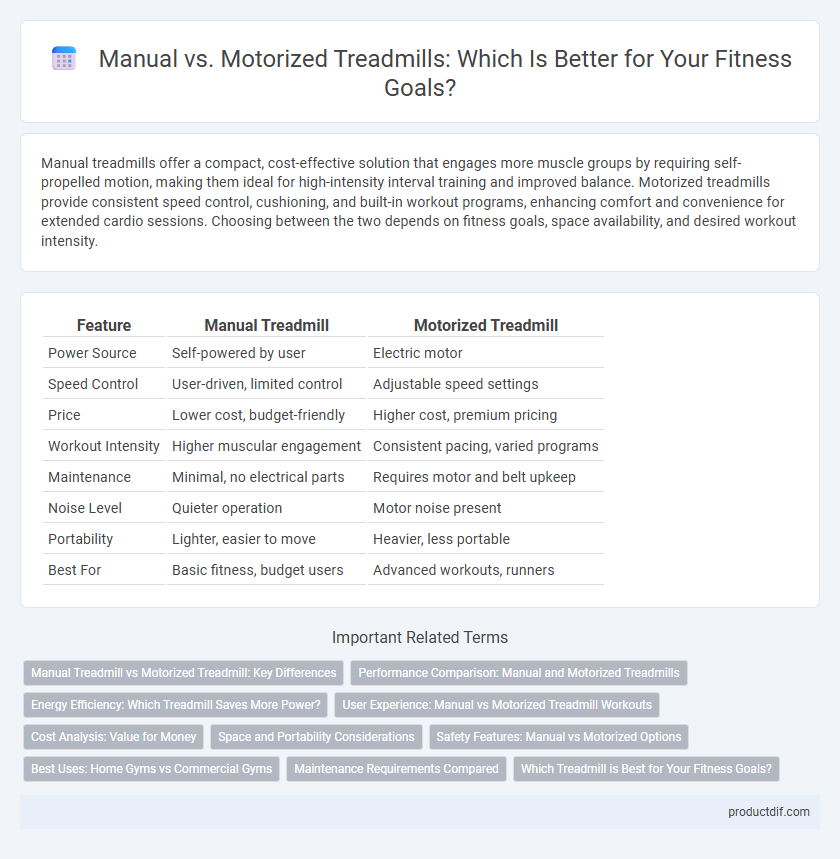Manual treadmills offer a compact, cost-effective solution that engages more muscle groups by requiring self-propelled motion, making them ideal for high-intensity interval training and improved balance. Motorized treadmills provide consistent speed control, cushioning, and built-in workout programs, enhancing comfort and convenience for extended cardio sessions. Choosing between the two depends on fitness goals, space availability, and desired workout intensity.
Table of Comparison
| Feature | Manual Treadmill | Motorized Treadmill |
|---|---|---|
| Power Source | Self-powered by user | Electric motor |
| Speed Control | User-driven, limited control | Adjustable speed settings |
| Price | Lower cost, budget-friendly | Higher cost, premium pricing |
| Workout Intensity | Higher muscular engagement | Consistent pacing, varied programs |
| Maintenance | Minimal, no electrical parts | Requires motor and belt upkeep |
| Noise Level | Quieter operation | Motor noise present |
| Portability | Lighter, easier to move | Heavier, less portable |
| Best For | Basic fitness, budget users | Advanced workouts, runners |
Manual Treadmill vs Motorized Treadmill: Key Differences
Manual treadmills operate through user-generated motion, requiring more physical effort and offering a compact, energy-efficient design ideal for low-impact workouts. Motorized treadmills feature adjustable speeds and inclines powered by an electric motor, providing customizable intensity levels and advanced tracking features for diverse fitness goals. Key differences include the level of control, maintenance needs, and price, with manual models typically being more affordable and motorized versions offering greater versatility.
Performance Comparison: Manual and Motorized Treadmills
Manual treadmills offer a more intense workout by engaging more muscles due to the self-powered belt movement, which enhances cardiovascular and strength performance. Motorized treadmills provide consistent speed and incline settings, allowing for controlled and varied training sessions ideal for endurance and interval workouts. Performance outcomes vary with manual models fostering greater calorie burn per minute while motorized versions enable precise workout customization for targeted fitness goals.
Energy Efficiency: Which Treadmill Saves More Power?
Manual treadmills consume no electricity as they are powered solely by user movement, making them the most energy-efficient option. Motorized treadmills require electricity to operate their motors, with power usage typically ranging from 600 to 700 watts during workouts. Choosing a manual treadmill can significantly reduce energy consumption and lower electricity bills while still providing effective exercise.
User Experience: Manual vs Motorized Treadmill Workouts
Manual treadmills require users to generate their own power by walking or running, providing a more intense, self-paced workout that engages core muscles and enhances balance. Motorized treadmills offer consistent speed and incline settings, allowing for customizable, low-impact cardio sessions suitable for all fitness levels. User experience differs as manual treadmills demand higher physical effort, while motorized treadmills provide convenience and precise control over workout intensity.
Cost Analysis: Value for Money
Manual treadmills generally offer lower upfront costs, making them an economical choice for budget-conscious fitness enthusiasts. Motorized treadmills, while pricier, provide advanced features like adjustable speed and incline, which can justify the higher investment through enhanced workout versatility and durability. Evaluating long-term value involves considering maintenance expenses and workout goals to determine which treadmill delivers the best cost-to-benefit ratio.
Space and Portability Considerations
Manual treadmills are compact and lightweight, making them ideal for small spaces and easy to move or store after workouts. Motorized treadmills typically require a larger footprint due to their heavier frames and built-in motors, limiting portability and space efficiency. Choosing a manual treadmill benefits users prioritizing space-saving fitness equipment without sacrificing basic treadmill functionality.
Safety Features: Manual vs Motorized Options
Manual treadmills offer enhanced safety due to the absence of a motor, significantly reducing the risk of sudden speed changes that can cause falls. Motorized treadmills include safety features such as emergency stop buttons and safety clips that immediately halt the belt during an emergency. Choosing between manual and motorized options depends on user preference for control versus advanced safety mechanisms typically found in motorized models.
Best Uses: Home Gyms vs Commercial Gyms
Manual treadmills are ideal for home gyms due to their compact size, low maintenance needs, and cost-effectiveness, allowing users to perform low-impact workouts and build endurance without electricity. Motorized treadmills are better suited for commercial gyms as they offer variable speed settings, advanced features like incline control, and durability designed to withstand heavy, continuous use by multiple users. Choosing between manual and motorized treadmills depends on workout intensity, space availability, and budget considerations specific to home or commercial environments.
Maintenance Requirements Compared
Manual treadmills demand less maintenance due to their simpler mechanical design and absence of electronic components, reducing the risk of motor or belt issues. Motorized treadmills require regular checks of the motor, belt alignment, and lubrication to ensure optimal performance and prevent costly repairs. Investing time in routine maintenance for motorized models extends lifespan, whereas manual treadmills primarily need occasional cleaning and belt tension adjustments.
Which Treadmill is Best for Your Fitness Goals?
Manual treadmills offer a low-impact, self-powered workout ideal for those seeking greater control over speed and intensity, making them perfect for interval training and muscle toning. Motorized treadmills provide consistent speed and incline settings, suitable for endurance training, weight loss, and cardiovascular improvement with features like pre-programmed workouts and heart rate monitoring. Choosing the best treadmill depends on your fitness goals, budget, and space availability, as motorized models typically require more maintenance and energy consumption compared to manual treadmills.
Manual Treadmill vs Motorized Treadmill Infographic

 productdif.com
productdif.com